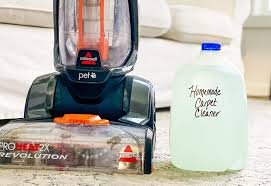
Carpet Cleaner Solution
Carpet Cleaner Solution is a critical component in maintaining the cleanliness, appearance, and longevity of carpeted surfaces. While vacuuming removes loose dirt and debris, deep cleaning with a carpet cleaner solution targets stains, odors, and embedded grime that regular cleaning tools cannot reach. With a growing variety of products on the market and the rise of eco-conscious consumerism, understanding what makes a carpet cleaner effective—and safe—is more important than ever. From homemade mixtures to commercial formulas, this article explores every angle of carpet cleaner solutions, including types, ingredients, usage tips, and how to select the right product for your needs.
Why Carpet Cleaning Solutions Matter
Carpets act like a filter, trapping dust, allergens, bacteria, and airborne pollutants. Over time, this accumulation not only affects the appearance of your carpets but also your indoor air quality and health. Carpet cleaner solutions help to remove these contaminants, freshen the fibers, and extend the lifespan of your flooring. They are especially vital in households with pets, children, or high foot traffic. A good carpet cleaning solution can also restore vibrancy, reduce odors, and prevent mold or mildew from setting into damp areas.
Types of Carpet Cleaner Solutions
There are several categories of carpet cleaning solutions, each designed for specific needs and equipment. Understanding the differences can help you choose the best one for your home or commercial space.
1. Carpet Shampoo
Carpet shampoo is one of the earliest forms of carpet cleaning solutions. It produces a rich foam that lifts dirt from the carpet fibers, which is then vacuumed away after drying. While effective for surface-level cleaning, traditional carpet shampoos may leave behind residues that attract more dirt if not thoroughly rinsed.
2. Carpet Steam Cleaning (Extraction) Solution
Steam cleaning solutions are used in hot water extraction machines. These solutions are designed to break down grease, grime, and embedded soil, allowing the hot water to flush contaminants from the carpet. This method is often recommended by carpet manufacturers and is known for deep cleaning and allergen removal.
3. Dry Carpet Cleaning Compound
These are low-moisture cleaning powders or granules that are sprinkled onto the carpet and then agitated and vacuumed up. They are ideal for water-sensitive carpets or areas where drying time needs to be minimized. While not as deep cleaning as steam solutions, they’re quick and efficient for maintenance.
4. Spot and Stain Removers
These are concentrated solutions or sprays designed to treat individual stains. Different formulas target different types of stains—such as pet urine, wine, coffee, or ink. They can be used alongside full carpet cleaning or on their own for quick touch-ups.
5. Eco-Friendly or Green Carpet Solutions
Eco-friendly carpet cleaning products use plant-based ingredients and biodegradable formulas. They avoid harsh chemicals like phosphates, chlorine, or artificial fragrances, making them safer for pets, kids, and allergy-sensitive individuals. Many green products are also cruelty-free and come in recyclable packaging.
Common Ingredients in Carpet Cleaning Solutions
A carpet cleaning solution is only as effective as its ingredients. Here are some of the most common and effective components you’ll find in both commercial and DIY solutions:
Surfactants: These are compounds that lower the surface tension of water, helping the cleaner to lift dirt and oils from carpet fibers. They act as the primary cleaning agents in most formulas. Non-ionic and anionic surfactants are most common.
Solvents: Used to dissolve oily and greasy substances. Glycol ethers and alcohols are frequent ingredients in powerful commercial formulas. In green cleaners, citrus-based solvents are often used as natural alternatives.
Enzymes: These are biological compounds that break down organic matter like food, blood, or pet urine. Enzymatic cleaners are highly effective for protein-based stains and odor removal.
Deodorizers: These ingredients neutralize or mask bad odors. They may be chemical or natural, such as baking soda or essential oils like lavender and lemon.
Antibacterial agents: Some solutions include disinfectants to kill bacteria and germs, particularly in pet-focused or hospital-grade cleaners.
pH adjusters: The pH of a cleaner can affect both its cleaning ability and its safety for certain carpet fibers. Most residential carpets do well with neutral or slightly alkaline cleaners, while wool carpets need pH-neutral products to avoid damage.
How to Use Carpet Cleaner Solutions Effectively
Using a carpet cleaner solution isn’t as simple as pouring and scrubbing. Proper application ensures better results and protects your carpet’s integrity.
1. Pre-treatment: For heavily soiled carpets or set-in stains, a pre-treatment step is often beneficial. This involves spraying a small amount of undiluted cleaner directly onto the affected areas and letting it sit for a few minutes before the main cleaning.
2. Dilution: Most carpet cleaning solutions are concentrated and need to be diluted with water according to manufacturer instructions. Using too much solution can leave behind residues; using too little may not clean effectively.
3. Equipment selection: Depending on the solution, you may need a steam cleaner, shampooer, or dry compound applicator. Make sure your machine is compatible with the type of solution you’re using.
4. Technique: Always clean in overlapping, slow strokes to allow the solution time to work. Avoid over-wetting, which can lead to mold growth or water damage underneath the carpet.
5. Rinsing and extraction: Some solutions require rinsing with clean water to remove residues. Others are low-foam or no-rinse. Always follow the label directions carefully.
6. Drying: After cleaning, ensure proper airflow and ventilation to speed up drying. Using fans or opening windows can help. Walking on wet carpets should be avoided to prevent re-soiling or imprinting.
Homemade Carpet Cleaner Solutions
For those who prefer DIY methods or natural alternatives, homemade carpet cleaning solutions can be highly effective for routine cleaning or stain removal. Here are a few tried-and-tested recipes:
1. Vinegar and Baking Soda Solution: Combine equal parts white vinegar and warm water in a spray bottle. Sprinkle baking soda directly onto the stain, then spray the vinegar solution. Let it fizz for a few minutes, scrub gently, and blot dry.
2. Dish Soap and Hydrogen Peroxide Cleaner: Mix 1 tablespoon of clear dishwashing liquid with 2 cups of hydrogen peroxide. This works well on light carpets for removing food and drink stains.
3. Essential Oil Freshener Mix: Combine 1 cup of warm water, 1 tablespoon of baking soda, and 10 drops of essential oil (like lavender or tea tree). This mix refreshes carpets and leaves a pleasant scent.
Note: Always test DIY solutions on a hidden area of the carpet first to check for colorfastness or damage.
What to Look for in a Carpet Cleaning Solution
With so many options on the market, choosing the right carpet cleaner can be overwhelming. Here’s a checklist of key factors to consider:
Carpet type compatibility: Not all solutions are safe for all carpet types. Check labels for wool-safe, synthetic-safe, or multi-surface indications.
Stain type: Choose a cleaner designed for your most common stain problems—pets, food, grease, etc.
Scent preferences: Some cleaners have strong chemical odors, while others are fragrance-free or use natural oils. Pick one based on your sensitivity.
Residue-free formula: A good cleaner won’t leave behind sticky residues that attract dirt or cause build-up.
Environmental impact: Consider biodegradable, non-toxic, and cruelty-free products if sustainability is important to you.
Machine compatibility: Ensure your cleaning solution works with your equipment—some formulas are made only for upright machines, others for portable or rental units.
Popular Carpet Cleaner Brands
Several well-known brands have gained popularity for their reliable and effective carpet cleaning solutions:
Bissell: Offers a wide range of pet-focused and deep-clean formulas, often optimized for their machines.
Hoover: Known for strong cleaning power and affordability. Their solutions are widely available in both scented and unscented versions.
Resolve: Popular for its spot and stain removers. Widely used in homes with pets and children.
Rug Doctor: Often paired with rental machines; offers professional-grade formulas.
Nature’s Miracle: Focuses on enzymatic cleaners ideal for pet stains and odors.
The Future of Carpet Cleaner Solutions
As consumer awareness grows around health, environmental safety, and indoor air quality, the carpet cleaner industry is responding with innovations. We’re seeing more plant-based formulas, smart dispensers that regulate chemical use, and even enzyme-boosted pods that offer convenience without compromise. Additionally, advancements in nanotechnology may soon allow micro-cleaners to penetrate fibers more efficiently and neutralize bacteria on a molecular level. The trend is clear: future solutions will focus on being safer, smarter, and more sustainable without sacrificing performance.
Conclusion
A clean carpet is more than a cosmetic improvement—it’s a health benefit, a comfort enhancer, and a property investment. Choosing the right carpet cleaner solution plays a central role in achieving those goals. Whether you opt for a commercial formula, a natural DIY blend, or a specialty product for pet messes or allergens, understanding what makes a solution effective will help you make better decisions. With the right techniques and knowledge, maintaining fresh, clean carpets becomes not just possible—but easy and rewarding.






